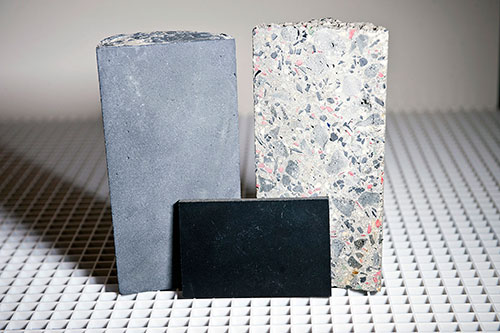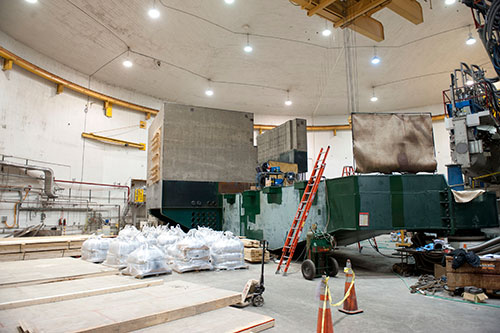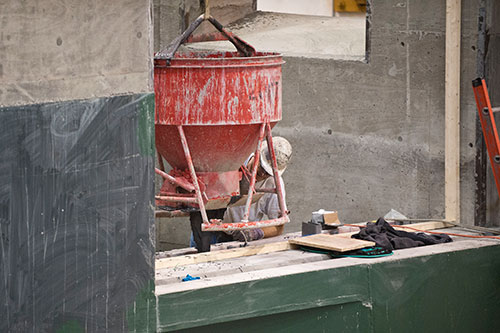Fifteen minutes seems like a lifetime to Paul Brindza. It's the average lifetime of a neutron, one of the many subatomic particles that scientists study at Jefferson Lab. While that may seem like a fleeting existence to us, the Hall C engineer says that it's more than enough time for the subatomic particles to do some real damage as they travel inside the hall.
Now, Brindza and his colleague Bert Metzger have devised a system of products to stop neutrons and other particles before they can inflict harm on sensitive scientific equipment and computers. Their patented and patent-pending products are currently being installed in Hall C.

Three new products developed at Jefferson Lab for shielding against neutrons consist of a boron-rich paneling for use in space-restricted areas (front), boron-rich concrete that absorbs neutrons using less material (left), and a lightweight concrete that is four times better at slowing down neutrons than ordinary concrete (right).
A Plethora of Particles
Neutrons are no strangers to Jefferson Lab scientists. They routinely probe these particles in the lab's Continuous Electron Beam Accelerator Facility in hopes of learning how protons and neutrons come together to form the nucleus of the atom. In a typical experiment, a stream of electrons from the CEBAF accelerator is directed into the nuclei of atoms in a target material. The result is a shower of protons, neutrons, electrons and other particles radiating away from the probe.
In Hall C, the High Momentum Spectrometer is positioned to capture some of these particles for study. A series of magnets focuses the shower of particles into a tight bundle and directs the bundle into the HMS shield house. The HMS contains several instruments that measure different characteristics of the particles, including detectors that start data collection, two chambers for measuring the positions of the particles as they travel, and counters for identifying the types of particles.
In a perfect world, all the particles would be captured and sampled in these detector systems. But in reality, many of the particles are so energetic, that they keep right on going into the next section of the HMS shield house, which is where much of the equipment and electronics that control the HMS collect and transmit the data from the detectors. Over time, the radiation generated in these experiments can damage this equipment.
"In modern electronics, the structures in the memory chips are very, very tiny. And they are sensitive to single-event damage. Which means a single particle can change a one to a zero. And that's what happens," Brindza says.
Eventually, these changes add up, and the software ceases to function. Then, the only way to fix the problem is to attempt a reboot so that the software can be reloaded. If that doesn't work, then memory cards must be replaced at a cost of around $100 each.
While that's an inexpensive fix, getting to that point is costly. Rebooting systems in Hall C takes about an hour on average, and an hour of CEBAF running costs more than $50,000. What's more, that time is subtracted from the running time of an experiment, which the experimenters usually do not get back.
Another Chance
For Brindza, the knowledge about the problems that the radiation can cause comes from nearly two decades of experience building, operating and maintaining the HMS.
"We built the HMS in Hall C 20 years ago, and we didn't have a lot of time to really optimize everything. We did the best we could and then learned from the problems we experienced in 20 years of running. We learned what worked, what did not work and most important, what we could improve," Brindza says.
The opportunity to improve on the design and function of the HMS arose as part of Jefferson Lab's 12 GeV Upgrade project. The $338 million project is doubling the energy of Jefferson Lab's primary accelerator and building a new experimental hall, along with other updates. More importantly for Brindza, the equipment in the three existing experimental halls is also being upgraded to capitalize on the accelerator's increased energy. Part of this work includes building a completely new apparatus, the Super High Momentum Spectrometer to complement the existing HMS.
Brindza is Hall C's lead engineer and is also the lead engineer for SHMS construction. He saw his chance to use the knowledge he'd gained from the HMS to better shield the equipment that will be installed in the SHMS from radiation.
"Getting rid of all the rest of the radiation is easy, but the neutrons are very difficult, and they prove to be the thing that is dangerous not only to the electronics, but also to the software that runs the electronics," says Brindza. "Those neutrons are very high energy that penetrate, that can go through concrete and walls and people."
Neutrons are a common byproduct of nuclear power generation, as well as the operation of particle accelerators, like the CEBAF accelerator. While materials for shielding against these particles exists, it can be bulky, expensive and difficult to manufacture. What's more, none of the current technologies met the requirements for the SHMS.
"Unlike the old spectrometer, the new one has a lot fewer wheels holding everything up, so we started running into size and weight limits. We needed to come up with a set of products that would lower the weight, but increase the shielding, less and more in the same package," he says.
So, Brindza and Metzger developed a system of products to better protect the equipment from radiation.

The Super High Momentum Spectrometer is under construction in Hall C. Bags of boron carbide for use in the boron-rich concrete sit on the floor in front of the partially complete concrete shield house.
New Shielding
The system they designed consists of three parts. Although it uses clever new techniques to shield against radiation, including neutrons, it works on the same principles as systems currently in use. It consists of a concrete layer to slow down neutrons, a material to absorb them and a thin lead layer to halt any residual radiation produced in this process.
The first part is concrete. Ordinary concrete can slow down, or thermalize, neutrons, but it would require a very thick layer of the stuff to work in Hall C. In concrete, the neutrons are thermalized when they strike hydrogen atoms in the water molecules that are trapped during the concrete mixing process. Brindza wanted to increase the concrete's ability to thermalize neutrons by adding hydrogen, while also decreasing its weight.
"What you want to do is add something to the concrete that adds hydrogen. And you want it to be permanent. So, we used a recycled product - shredded plastic waste from molding products. Plastic is mostly hydrogen and carbon and a little bit of chlorine," Brindza explains.
To make the concrete even lighter, he and his colleagues then removed all of the grit and rocks that are normally used in concrete and added in a lightweight shale product. The result is a concrete that will provide the majority of the structure for the SHMS shield house. The product looks and pours like ordinary concrete but has four times the capability to thermalize neutrons, and it is two thirds the weight of ordinary concrete with the same strength.
Once you've thermalized the neutrons, you're only halfway toward the goal of eliminating them. While a neutron is bound up inside a nucleus with protons, it can remain there indefinitely. Should a neutron be freed of the nucleus by the CEBAF accelerator's electron beam, as often happens in experiments at Jefferson Lab, then that neutron can drift around for another 15 minutes before falling apart into less-harmful particles.
"They become like the gas in the room. They go with the air conditioning. If you open the door, they come out. They'll go under the door. They'll come through a pipe. They go around corners. They go further, because they're not charged," Brindza says.
And everywhere they go, they can wreak havoc on experimental equipment and electronics. So, the next step after you thermalize the neutrons is to stop them in their tracks.
For that, Brindza developed the second part of the system, which is concrete that is heavily loaded with boron to absorb the neutrons. Boron has long been used in nuclear power plants and in particle accelerators to absorb neutrons that have been thermalized.
But boron is tricky to work with. Some neutron shielding systems use metal boxes packed with boron in its dry, powdered form, but boron resists dense packing due to electrostatic forces, filling only about 50 percent of a box per unit of volume. Those boxes would have taken up valuable space in the SHMS shield house.
Another way to use boron is to just add it to standard concrete. However, using this type of boron-enriched concrete would have required pouring a foot-thick layer of the stuff. This solution, too, would have added to the weight and cost of the shielding, while reducing the amount of space available in the shield house.
So, Brindza and Metzger formulated a new recipe for concrete that is heavily loaded with boron.
"It's a concrete mix without any stone in it. It has a variety of other things. And what we worked out is that you can make concrete out of boron and chemicals and leave out everything else. So, it's basically only boron material, Portland cement and water, plus it is also as strong as ordinary concrete," he says.
Boron-rich concrete has the same consistency as ordinary concrete. It will be used as a second, six-inch-thick protective layer behind the lightweight structural concrete in the SHMS shield house, enclosing the room in which the electronics are encased. Thin lead plates will be applied behind this concrete to stop any other radiation that may result from the neutron-boron collisions (typically, 1 MeV X-rays). This lead layer will be covered with an aluminum panel to prevent human contact with the lead and to allow easy attachment of room fixtures, such as lights and electrical outlets. In other applications, the thin lead plates may be replaced with thicker ones made from iron, which can accomplish the same task as lead, but require a thicker design.
"We didn't try to make the boron-rich concrete light, we tried to deliberately make it have as much boron in it as possible. We used boron carbide because it has more boron - it's carbon with four borons. So, you start with something that's already got 76 percent boron, and then you pack it in better then anybody, and now you've got the best thermal neutron shielding material in the world," he adds.
The estimates for the improved shielding performance and design were obtained from a Monte Carlo calculation performed by Tanja Horn, an assistant professor of physics at The Catholic University of America, Steve Wood, Jefferson Lab’s Hall C leader, and Rolf Ent, formerly 12 GeV Upgrade Science Lead and currently Jefferson Lab's Associate Director of Nuclear Physics. The calculation was based on 15 years of data from the existing HMS. Brindza and Metzger hope to fully quantify the performance of the new concrete materials once the first experiments begin running in Hall C after the completion of the 12 GeV Upgrade Project by 2017. The real proof will be improved experiment up time performance which means more data for every experiment.
He and Metzger also applied parts of the materials-replacement idea they used in the boron-rich concrete to making a thin panel of boron-impregnated shielding for areas in which a dense concrete block wasn't needed. For this product, they turned to the process for making molded countertops. They replaced materials used in countertops with boron, resulting in a panel less than an inch thick and consisting of boron embedded in an epoxy resin. The panels are manufactured by Vintage Stone at a shop that is located nearby in Oyster Point.
"We pre-made the panels. And we had another contractor take a panel of boron, a skin of lead and an aluminum cover and put it together into something that can be installed and handled, so it is environmentally friendly," he says.

A worker pours the boron-rich concrete into a form inside the partially complete Super High Momentum Spectrometer shield house in Jefferson Lab's Hall C
Whipping Up Concrete
The new products are also budget friendly. The total cost for the structural components of the SHMS, which includes the lightweight concrete, the boron-rich concrete, the panels and other components will total around $1 million. Of that, about $350,000 is for the bags of boron powder for the boron-rich concrete.
However, had he chosen to go with the traditional recipe of simply adding boron to ordinary concrete, the cost would have been double that, and the SHMS would have needed to have been designed with a larger footprint, higher weight and at additional structural cost.
In addition, Brindza opted to have the boron concrete mixed onsite in a concrete mixer now located in the hall, saving nearly $100,000 over the cost of having the material made at a concrete ready mix plant and then trucked in.
"So, an ordinary concrete truck is about a nine-yard truck. When you get done pouring, there's still a yard left in there. And this stuff costs $30,000 a yard. So, cleaning the truck out costs you $30,000. Using half a dozen trucks, a lot of money gets dumped on the ground in an ugly slump," he explains. "So, we're using a small batch plant in the hall. We mix it, dump it, mix it, dump it, and keep going. And then once a day, we clean it. So, we lose very little."
A local company, Branscome, makes up all the concrete according to the special recipes. The lightweight concrete is made at a ready mix plant, and the boron concrete is mixed on site. Another contractor, Hylton Builders, Inc., fabricates all the forms and then pours the concrete. The construction of the SHMS Shield House is currently on schedule for completion in December 2013, on time and on budget. The SHMS Spectrometer has a scheduled completion date of February 2016.
Brindza says the benefit of having taken cost into consideration in the development of recipes for the system of shielding materials are products that are highly versatile and easy to manufacture.
"We needed to not just optimize the shielding, but to optimize the process of making it and installing it. The stuff we made, any concrete company can pour it. We did a lot of work and engineering to make a product that anybody could dump into place and form up," he says.
Brindza says he hopes that his and Metzger's builder-friendly recipes will soon benefit others. The system may have applications in such wide-ranging fields as the storage of nuclear waste, shielding of radiation sources used in medical applications and in compact nuclear reactors.
The boron-rich concrete technology, "Thermal neutron shield and method of manufacture," has been granted patent #8,450,707 by the U.S. Patent and Trademark Office. The two other technologies, "Lightweight Concrete with Enhanced Neutron Shielding" and "Cost Effective Boron Shielding Panels," are patent pending. All three technologies are currently available for licensing by interested companies.
Contact: Kandice Carter, Jefferson Lab Public Affairs, 757-269-7263, kcarter@jlab.org

